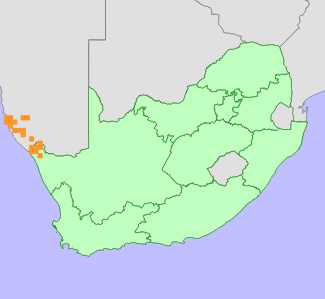|
Scientific Name | Stipagrostis geminifolia Nees |
Higher Classification | Monocotyledons |
Family | POACEAE |
Synonyms | Aristida geminifolia (Nees) Trin. & Rupr. |
National Status |
Status and Criteria | Near Threatened* B1ab(iii,v)+2ab(iii,v) |
Assessment Date | 2015/05/24 |
Assessor(s) | D. Raimondo & P.C.V. Van Wyk |
Justification | This species has a national extent of occurrence (EOO) of 2776 km², and is known in South Africa from fewer than 10 locations, where it is declining due to livestock grazing and mining. The South African population is continuous with the larger, stable Namibian population, and therefore the national status is downgraded by one category following IUCN regional assessment procedures. It is therefore assessed as Near Threatened under criterion B. |
Distribution |
Endemism | Not endemic to South Africa |
Provincial distribution | Northern Cape |
Range | This species occurs from southern Namibia (Sperrgebiet) to the Gariep Valley and central Richtersveld, Northern Cape, South Africa. |
Habitat and Ecology |
Major system | Terrestrial |
Major habitats | Northern Richtersveld Yellow Duneveld, Western Gariep Lowland Desert, Western Gariep Plains Desert, Lower Gariep Alluvial Vegetation, Richtersveld Red Duneveld, Richtersveld Coastal Duneveld, Northern Richtersveld Scorpionstailveld, Upper Annisvlakte Succulent Shrubland, Alexander Bay Coastal Duneveld, Richtersveld Sheet Wash Desert |
Description | Plants grow in gravelly flats and drainage lines. |
Threats |
| This species' entire known range in South Africa is severely overstocked with livestock, and overgrazing is causing an ongoing decline. Subpopulations along the lower Gariep Valley are also threatened by habitat loss to mining. |
Population |
This species has a limited range in South Africa, and persists in only a few places. The South African population is continuous with Namibia, where this species is more widespread, and possibly more common, and not severely threatened. It is therefore likely that the South African population could be supported by dispersal from the Namibian population (rescue effects).
|
Population trend | Decreasing |
Assessment History |
Taxon assessed |
Status and Criteria |
Citation/Red List version | | Stipagrostis geminifolia Nees | NT* B1ab(iii,v)+2ab(iii,v) | 2015.1 | | Stipagrostis geminifolia Nees | Least Concern | Raimondo et al. (2009) | |
Bibliography |
De Winter, B. 1965. The South African Stipeae and Aristideae (Gramineane). An anatomical, cytological and taxonomic study. Bothalia 8(3):199-404.
Raimondo, D., von Staden, L., Foden, W., Victor, J.E., Helme, N.A., Turner, R.C., Kamundi, D.A. and Manyama, P.A. 2009. Red List of South African Plants. Strelitzia 25. South African National Biodiversity Institute, Pretoria.
Snijman, D.A. 2013. Plants of the Greater Cape Floristic Region 2: The extra Cape flora. Strelitzia 30. South African National Biodiversity Institute, Pretoria.
|
Citation |
| Raimondo, D. & Van Wyk, P.C.V. 2015. Stipagrostis geminifolia Nees. National Assessment: Red List of South African Plants version . Accessed on 2025/08/18 |
 Comment on this assessment
Comment on this assessment


